The universe is just
What is this article about
This article is one of the fruits of thinking (blurred for several years) over the consequences arising from one simple idea: the Universe has no creator, and if so, the complexity in its structure is simply no place to take. Let's call it a basic principle. In this article I will try to apply the resulting approach to solving problems related to nature. Such tasks, for example, can be: the device of the Universe, evolution, the device of the brain and the intellect, models of all sorts of different social phenomena and the like. It is in this article that we will try to build a model of the Universe that satisfies the basic principle. Well, it would be good if the model did not at least contradict the observable Universe. Otherwise, what's the point?
And just before the start I want to immediately warn you - by profession I am not a physicist, so the model built will be rather a sketch, an example of where the basic principle applied here can lead. The article does not pretend to any scientific, okolonauchnost, truth or correctness, there will not be strict evidence, formulas and consideration of the entire decision tree. This article is rather the result of the construction and application of the greedy algorithm to the solution of the problem, and as you know, greedy algorithms do not necessarily give the correct answer. So I warned you.
Algorithm
So, our task is to build a model of the universe, armed with a basic principle. To do this, first, we will maintain two invariants:
- Invariant 1: derives directly from the basic principle - the basis of the model should be simple. By simple, I understand something that is the basis. If we have two basic things in the model, this will be a violation of the invariant. If this one of them has a too complex internal structure, this will also be a violation;
- invariant 2: the model should not contradict the observable Universe.
Secondly, we will restore the broken invariants with the least amount of simple steps and from two options we will also choose the one that is simpler and adds fewer new entities, or does not add them at all. If there are two options for the development of events and one leads to the fact that the problem is not solved - we choose the second. If you come up to a dead end - go back and select the arch with the least difficult solution from the rest.
Getting a solution
At the moment, of all the diversity of knowledge about the Universe, we will be interested only in those who violate invariant 1 most of all. There is the Universe that we observe, consisting of space, energy, matter (and their dark brethren), gravity and time. Since time is in its essence a distance, it can be safely removed from consideration and kept in memory that everything that applies to a distance can also be applied to time.
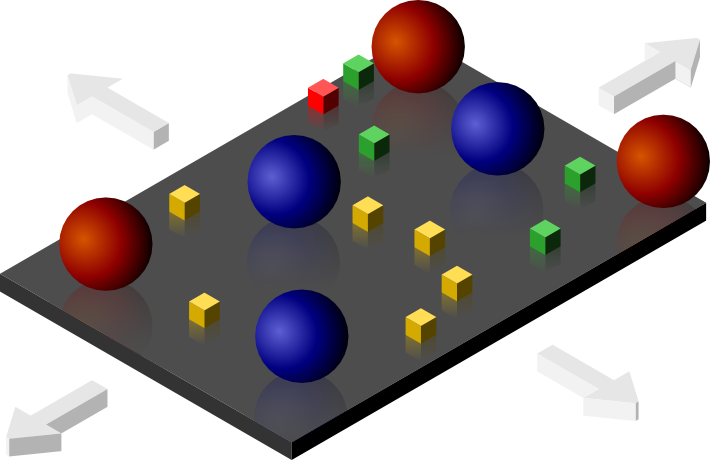
The space is indivisible and is curved near the matter with mass. The universe is constantly expanding and this is somehow related to dark energy, the metric of space and the Hubble constant. All matter consists of building blocks - atoms and molecules, which themselves consist of protons and neutrons, which in turn consist of even smaller subnuclear particles of which there are hundreds, stable and unstable, which can decay, turn into each other, be absorbed and emitted. There is still gravity and its carrier, and how dark matter is associated with it and it is not yet clear what to do with all this.
Step 1. Matter
Since subnuclear particles can transform into each other - it can be assumed that the basis of the whole variety of matter is one basic particle, and since matter and energy are one and the same, we will also bring energy to this basic particle. This, although a bit, brings us closer to the restoration of invariant 1.
What properties should our basic particle have? It does not have to be stable (it can disintegrate), it can be transformed into another sub-nuclear particle or be absorbed by it. A combination of some unstable subnuclear particles can produce a stable subnuclear or nuclear particle. At the same time, having got into a black hole, the matter constructed of such particles continues to maintain its mass, and hence its stability.
Step 2. Gravity
At the previous step, we reduced all the diversity of matter and energy to a single basic particle, without destroying invariant 2 (well, at least I would like to think so), but space, dark energy, gravity and dark matter still remain. Since dark energy and dark matter are in their essence crutches and it is still not entirely clear what to do with them - we will throw them out of consideration for the time being (as a result of the expansion of the Universe) and thereby violate invariant 2. To be honest, with gravity it’s not very clear what to do - we’ll throw her out. In the future, to restore invariant 2, it will be necessary to return all this somehow. It remains the base particle and space.

Step 3. Space
Having space and a base particle is still too complicated. At this step, the space no longer expands and does not warp, but if we leave everything as it is, restoring invariant 2 will have to answer a large number of uncomfortable questions, for example, how is the current value of the Hubble constant maintained throughout the Universe? Even in that part of it, which is beyond the horizon of events. What will happen if in one part of the Universe there is one speed of expansion into another, will it not break our space? What is gravity and who is the carrier? And so on. If you think so - empty continuous space creates more problems and is incomprehensible in its essence. In order to reduce the space and the base particle to something one - the simplest solution that I could come up with,
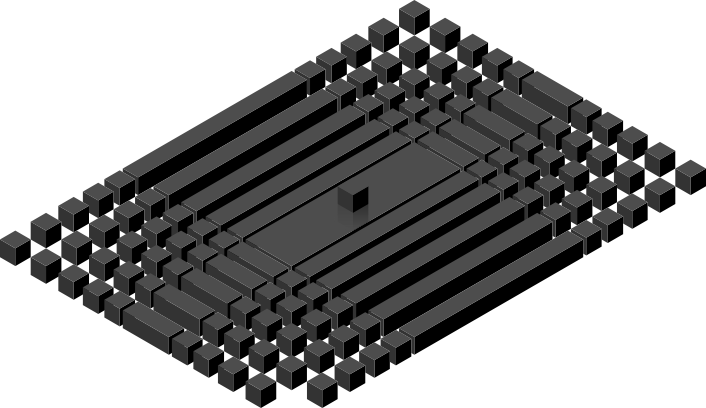
We replace the base particle and space with a quantum of space (hereinafter, the word quantum will be understood as the quantum of space, in the framework of this article it is an independent term that has no relation to the traditional quantum in physics). While it is not very clear what it gives us, but we have a restored invariant 1. All subsequent steps we will restore invariant 2, without breaking invariant 1.
Step 4. Quantum properties
So far, our entire universe consists of a single quantum.

There is nothing outside of this quantum. We need to add to our quantum the minimum necessary number of properties in order to restore invariant 2. We begin with the expansion of the Universe. It's simple - just give our quantum the opportunity to split into two copies of itself (well, or generate our own copy).
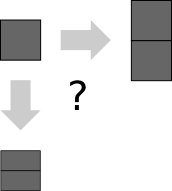
The first question that arises - before there was one particle and Nothing, now two particles have appeared - how much space do these two quanta occupy now? Is it possible that Nothing has taken on the role of a classical continuous space? What I like most is the option of expanding the Universe into itself. Perhaps for an outside observer, our entire Universe does not occupy any volume at all, and from the inside the volume of the Universe is now equal to two quanta.
It would also be nice to answer the question - how exactly does a quantum generate its copy? It turns out that the quantum itself is a complex object. Perhaps he clones himself, can be stretched, remaining one and the whole Universe consists of one long string, rolled into a ball. In fact, in this article it is not so important. For now, we assume that a not too complex quantum device will not violate invariant 1.
Creating a copy can be both deterministic and random. It is easier for me to consider it as a random process, but, in principle, it is possible to replace the probability with a frequency and it will be about the same. The probability of generating a new quantum is not very large, otherwise the Universe would grow at an incredible pace, however, even a small increase will provide an accelerated dispersal of any two quanta relative to each other.

The bonus is that in order to explain the expansion of the Universe, we no longer need dark energy.
Step 5. Base particle
In this step, we already have some amount of space that is expanding. What properties should it have? First, space has such a concept as density - since the process of generating a new quantum is random, it may be that in one part of the space of quanta there will be slightly more than in the other.
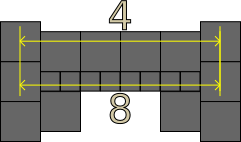
Thus, the distance between two points can be different and depend on the observer. Clots, as well as rarefied parts of space, should strive for dispersion and comparison with the average density of the surrounding space of the Universe. If it were otherwise, it would be a violation of the laws of the observable universe. Also, there can be no gap between neighboring quanta, because one more entity would have to be introduced. In this regard, space, although quantized, is continuous.
Now it would be good to restore the base particle we got rid of in step 3. One could try to add a separate bit to the properties of the quantum, which turns the quantum into a basic particle. But this entails a lot of difficulties - you have to somehow make moving such a quantum in space or at least this bit, then you will need to figure out how to transform the base particle into one of the subatomic ones and the like.
I like the idea that the base particle is somehow a cunning curvature in space. What we have the most suitable for the role of curvature? The density of our quantized space. What if an additional parameter were introduced in a quantum, and a quantum with such a special parameter would create ordinary quanta with a higher probability?
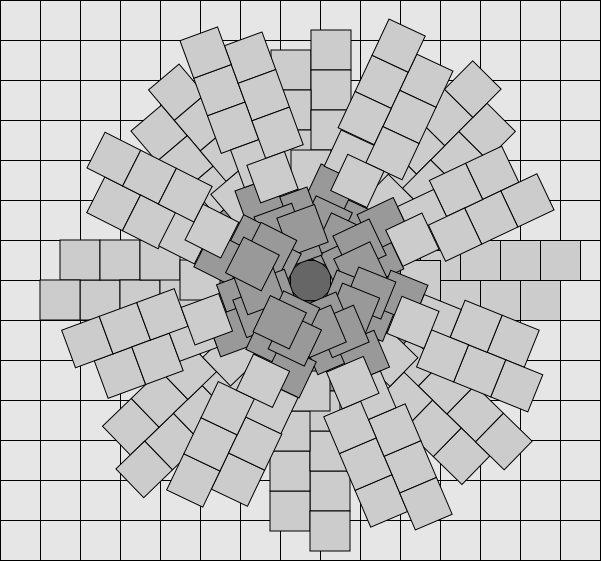
Around such a quantum there will always be an area with an increased density of space, which will fall in inverse proportion to the distance from the center (for an external observer) until it is equal to the average density of the surrounding space. This is already a good candidate for the role of a basic particle, but I don’t want to introduce additional hidden properties for quanta, and even for different quanta are different - quanta should be all the same.
And can such a basic particle move in space? In a sense, yes, but only constantly moving away from everything around.
The solution to the problem with moving can be the introduction of a new property in a quantum - the ability to stick together two quanta in one, or to absorb one quantum of another. Mergers and acquisitions - yes, it's all about them. Such a quantum could swallow a neighbor on one side and thus move closer to another quantum. It is already possible to move in such an environment, but there is still a problem with the basic particle, how can we recreate it? In principle, this is solved if we assume that the quantum is asymmetric.

On one side, the probability of merging with a neighboring quantum is higher, on the other, the probability of generating a copy of itself is higher, and merging is impossible. If we replace our quantum with this, then to maintain the expansion of the Universe it is enough that the probability of merging is slightly lower than the probability of separation, while the probabilities themselves can now be relatively large. Then in small areas it will seem that the space is boiling - the quanta constantly appear and disappear, and at large distances our space will simply gradually expand.
When a quantum is asymmetric, with some probability, combinations of several quanta will be formed, which can either generate new quanta with a higher probability or absorb them more likely. Maybe one asymmetry is not enough and it is necessary that the mutual orientation of quanta suppresses or enhances the properties of each other. This is not so important in this article.

Most likely such combinations will be unstable, but one of these combinations will be our basic particle. Strictly speaking, to save invariant 1, it is no longer necessary that there be exactly one basic particle - there can be several of them.
Step 6. Stable particle
So - we have a candidate for the basic particle. These are quanta in a special way relative to each other. To move in space, it is enough that such a particle absorbs more quanta in the direction of its movement and either creates quanta from the other side or absorbs them more slowly. In this case, in fact, the particle itself always remains in place, the number of quanta from the direction of motion decreases, and the movement occurs due to the alignment of the density of space. But such a basic particle will be unstable. When colliding with any other particle, the structure (or the nucleus) will be broken - the mutual arrangement of the quanta and the particles are likely to disintegrate. But, with a small probability, several unstable particles can form one stable. What properties should a stable particle have? The main property - it should not give to destroy its core. To do this, it must constantly generate around itself new quanta, that is, generate space. Let's call this the barrier separating the core from ordinary space. If you do this quickly enough, then no other particle can come close and the core will be a white hole. But in order to move in space, such a particle must, on average, as a result of its activities, either not add new quanta or reduce their number. Why is that? The nucleus itself cannot move - it can only create new quanta, and it needs to absorb it. Then a barrier should be created around the core of, for example, unstable structures that absorb more. Then such a particle will still be a white hole, but it will be able to move. So far this is the easiest option that I managed to come up with - the core is a generator of unstable particles that form an insurmountable barrier, and the barrier itself, on average, absorbs quanta from the surrounding space more often. The radius of the barrier is ultimately determined by the rate at which new particles generate nuclei.

Step 7. Mass
We have a Universe that expands and there are first stable particles. At this step, I propose to rise to a higher level and treat the stable particle as one object. A stable particle has two beneficial properties - it is impossible to get close to its core and this particle absorbs space. The bonus of this behavior is the appearance of the mass of such a particle and the larger the mass, the greater the rate of absorption of space by this particle.
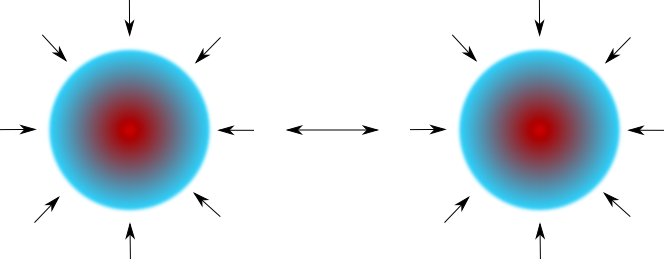
If two particles are left to hang motionless in space, they will absorb the space around them until the space between them remains completely. Then both of them will rest on the barrier of each other, they will constantly come closer together a little, then be removed, flying constantly past the core of a neighbor. From the point of view of particles - they move towards each other, fly by, move away a little and come closer again. Thus, at this step, we restored gravity and most likely got rid of dark matter. Gravity in our model is nothing more than the absorption of space by matter. At the same time, if two particles hang far enough from each other, then, starting from a certain distance, the absorption speed of two particles will not be enough to cope with the expansion of the Universe, and such particles will begin to move away from each other.
Step 8. Conclusions
At this step, in principle, you can complete the work of the algorithm, since invariant 2 is restored. At the level of matter, the law of energy conservation should already work, which, in general, does not necessarily work at the level of quanta.
The universe is expanding, unstable particles appear and disappear with a relatively high probability. With a very small probability, stable particles are formed from them, for example, protons and neutrons, which are then collected into gas giants by gravity. This process is accelerated by the fact that a massive object, like a vacuum cleaner, sucks a huge amount of space into itself and at the expense of it pulls up all new and new particles. When the critical number of atoms is reached, the gas giant turns into a star. Since the process of absorption of space goes on constantly, new gas giants will form outside the heliosphere of the star, then all this is supposed to grow into a small ball of stars, the closer to the first star, the closer they will be to each other. And after the black hole appears, a dwarf galaxy will appear. It will already be more similar to the classic whirlpool. At the edges of the galactic arms of hydrogen dust drawn from intergalactic space, the stars will flare again and again. And this whole process within the framework of one galaxy will continue forever, since new stable particles constantly appear in interstellar space.
Just as sound propagates in water, so gravitational waves from the collision of massive objects propagate in the form of altered density.
Even if the particle has no mass, it will still be attracted to the object with the mass, and flying next to it will change its trajectory. The motionless particle in orbit, for example, of the Moon will eventually fall on its surface simultaneously with the space quanta surrounding this object. Up to touching the surface of the moon, such a particle will experience weightlessness.
We, on Earth, are inside a giant waterfall, but instead of water, streams of space fall upon us.
In our model, all this is possible due to the asymmetry of the quantum and the exact value of the probabilities (or frequencies) of creating a new quantum and absorption. The exact values violate invariant 1, so we can assume that in Nothing there are many different quanta, with different asymmetries and different probabilities. As a result of them different strange things turn out, sometimes Universes.
How to check
Probably the easiest way to check if space is quantized and whether space is absorbed by matter is to simulate the rotation of stars in the galaxy relative to its core. If it is possible to eliminate the discrepancy between theory and observation in the rotational speeds between the stars that are closer to the core and those on the outskirts, then the space is most likely quantized.
Another option is to try to make a model of a proton and an electron and see how they will behave.
